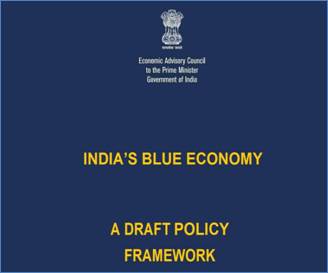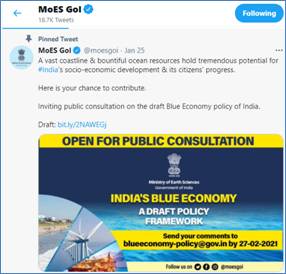The Ministry of Earth Sciences (MoES) has rolled out the Draft Blue Economy policy for India in the public domain inviting suggestions and inputs from various stakeholders including industry, NGOs, academia, and citizens. The draft blue economy policy document outlines the vision and strategy that can be adopted by the Government of India to utilize the plethora of oceanic resources available in the country. The policy document has been disseminated for pubic consultation on several outreach platforms including websites and social media handles of MoES and its institutes. Stakeholders have been invited to submit inputs and ideas by February 27, 2021. The policy document aims to enhance contribution of the blue economy to India’s GDP, improve lives of coastal communities, preserve marine biodiversity, and maintain the national security of marine areas and resources.
India’s blue economy is understood as a subset of the national economy comprising an entire ocean resources system and human-made economic infrastructure in marine, maritime, and onshore coastal zones within the country’s legal jurisdiction. It aids the production of goods and services that have clear linkages with economic growth, environmental sustainability, and national security. The blue economy is a vast socio-economic opportunity for coastal nations like India to utilize ocean resources for societal benefit responsibly.
With a coastline of nearly 7.5 thousand kilometers, India has a unique maritime position. Nine of its 29 states are coastal, and the nation’s geography includes 1,382 islands. There are nearly 199 ports, including 12 major ports that handle approximately 1,400 million tons of cargo each year. Moreover, India’s Exclusive Economic Zone of over 2 million square kilometers has a bounty of living and non-living resources with significant recoverable resources such as crude oil and natural gas. Also, the coastal economy sustains over 4 million fisherfolk and coastal communities. With these vast maritime interests, the blue economy occupies a vital potential position in India’s economic growth. It could well be the next multiplier of GDP and well-being, provided sustainability and socio-economic welfare are kept center-stage. Therefore, India’s draft blue economy policy is envisaged as a crucial framework towards unlocking country’s potential for economic growth and welfare.
The MoES prepared the draft blue economy policy framework in line with the Government of India’s Vision of New India by 2030. It highlighted blue economy as one of the ten core dimensions for national growth. The draft policy framework emphasizes policies across several key sectors to achieve holistic growth of India’s economy. The document recognizes the following seven thematic areas.
- National accounting framework for the blue economy and ocean governance.
- Coastal marine spatial planning and tourism.
- Marine fisheries, aquaculture, and fish processing.
- Manufacturing, emerging industries, trade, technology, services, and skill development.
- Logistics, infrastructure and shipping, including trans-shipments.
- Coastal and deep-sea mining and offshore energy.
- Security, strategic dimensions, and international engagement.


Snapshot of the Draft Blue Economy Policy Document for India prepared and circulated by the Ministry of Earth Sciences (MoES), Government of India (left). MoES inviting public consultation on the Draft Blue Economy Policy document by stakeholders through widespread outreach on social media handles of MoES and its institutes (right).
The United Nations Member States, including India, adopted 17 sustainable development goals (SDGs), also known as the Global Goals, in 2015 as a universal call to take action to end poverty, protect the planet, and ensure that all people enjoy peace and prosperity by 2030. SDG 14 seeks to conserve and sustainably use the oceans, seas and marine resources for sustainable development. Several countries have undertaken initiatives to harness their blue economy. For instance, Australia, Brazil, United Kingdom, United States, Russia, and Norway have developed dedicated national ocean policies with measurable outcomes and budgetary provisions. Canada and Australia have enacted legislation and established hierarchal institutions at federal and state levels to ensure progress and monitoring of their blue economy targets. With a draft blue economy policy framework of its own, India is now all set to harness the vast potential of its ocean resources.
The Draft Blue Economy policy document prepared and circulated by the MoES is available at https://moes.gov.in/writereaddata/files/BlueEconomyPolicy.pdf. Comments and suggestions should be sent via email to blueeconomy-policy@gov.inby February 27, 2021.
*****
NB/KGS/(MoES Release)


